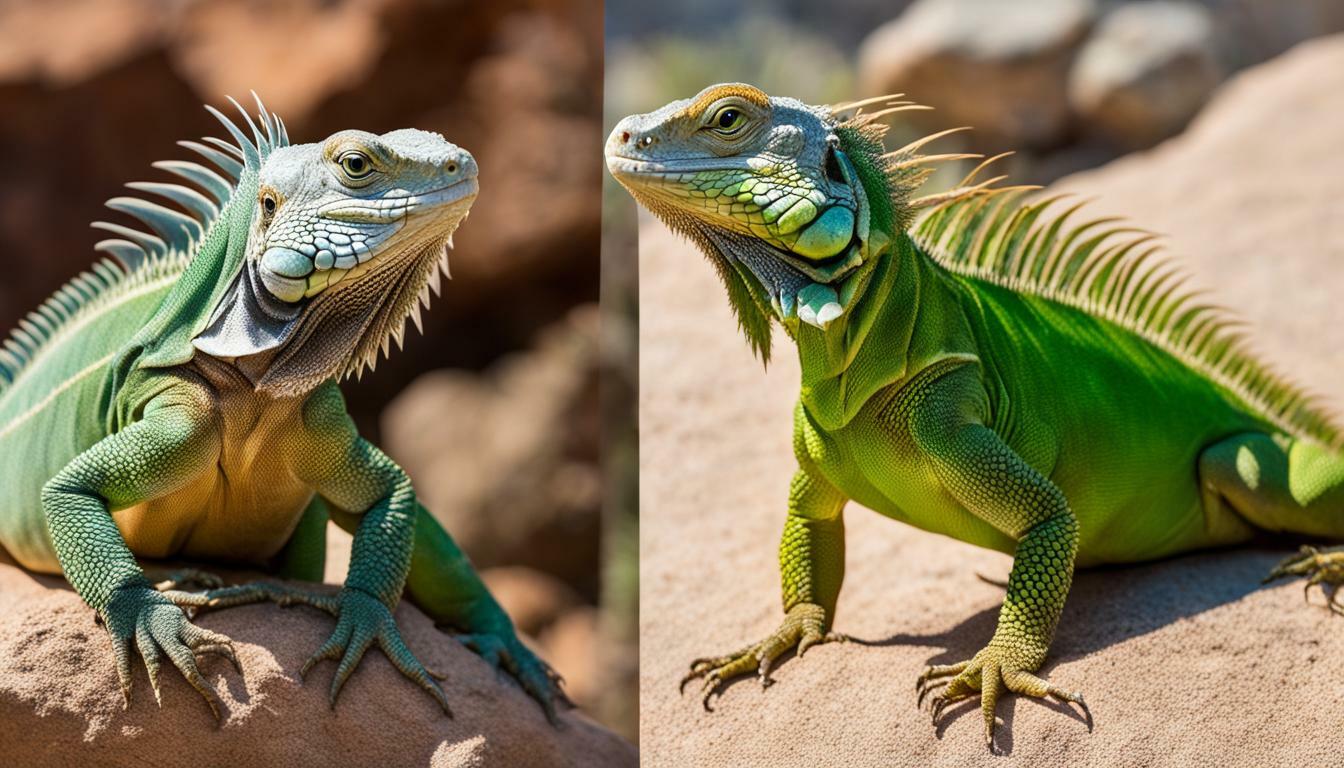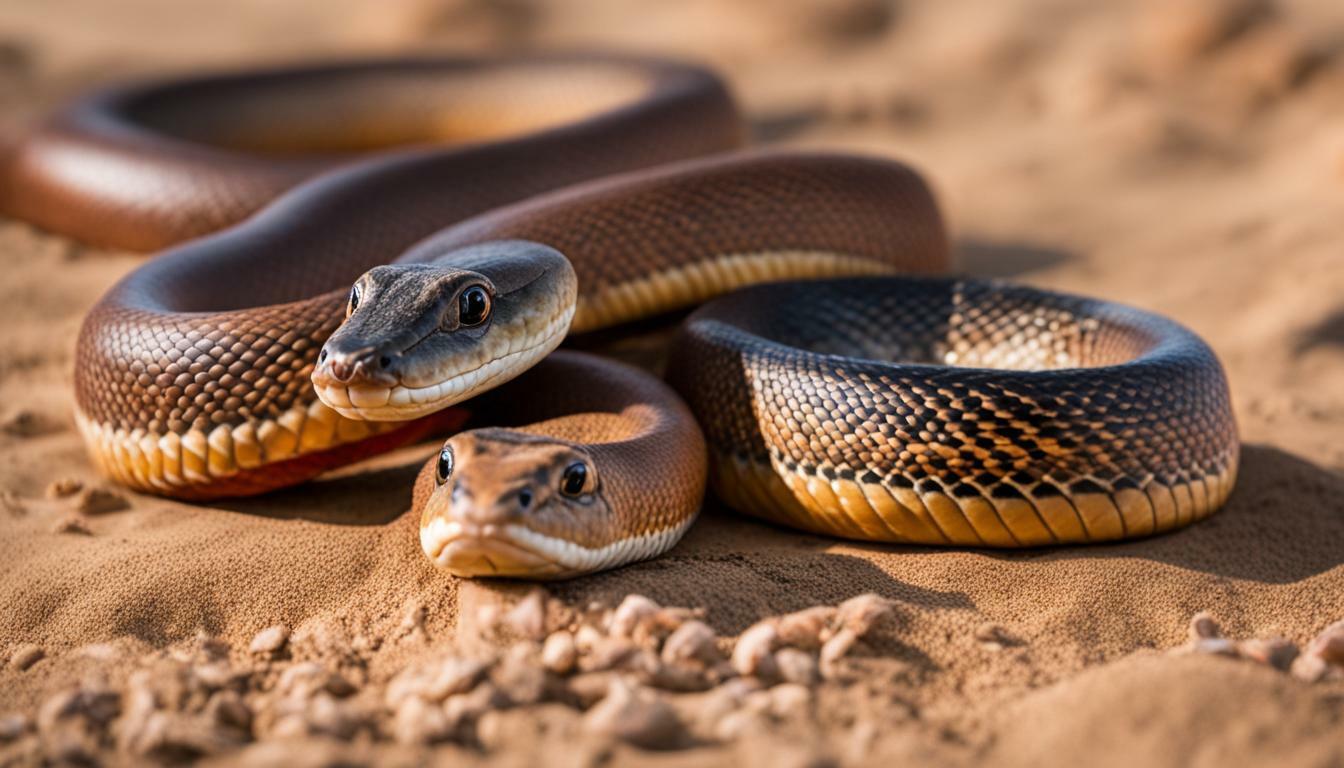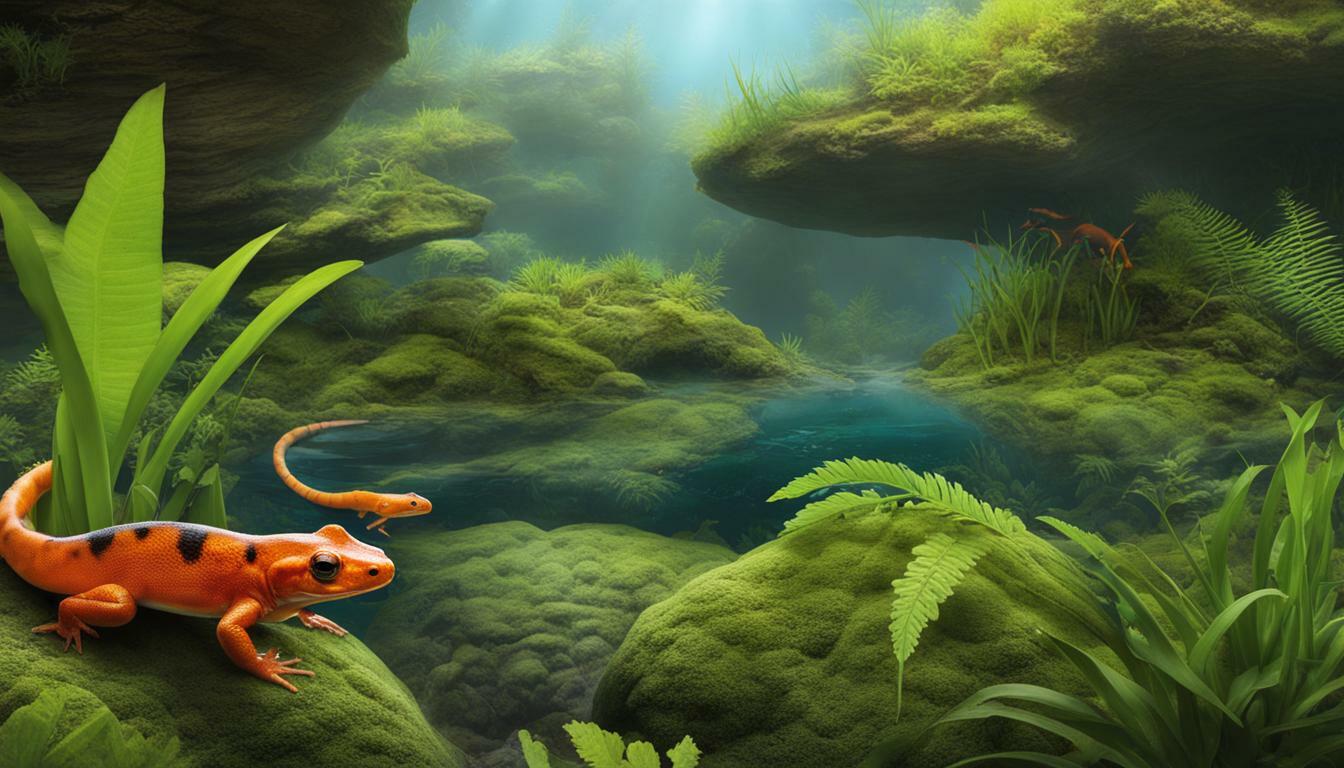If you’re curious about the difference between Desert Iguanas and Collared Iguanas, you’ve come to the right place. These two species of lizards, found in the desert, have distinct characteristics that set them apart. Let’s explore the variations between them.
Key Takeaways:
- Desert Iguanas and Collared Iguanas are two different species of lizards found in the desert.
- The Desert Iguana is primarily herbivorous and can tolerate high temperatures, while the Collared Iguana is a predatory lizard with strong jaw muscles.
- They exhibit different color patterns and markings.
- Both species should be approached with caution as they can bite.
Desert Iguana Characteristics
The Desert Iguana, scientifically known as Dipsosaurus dorsalis, is a fascinating lizard species found in desert regions. With its unique traits and adaptability, the Desert Iguana has carved its niche in these harsh environments.
One of the notable characteristics of the Desert Iguana is its herbivorous diet. Unlike its carnivorous counterparts, this lizard primarily feeds on plants, including fruits, flowers, and leaves. These herbivorous tendencies allow the Desert Iguana to sustain itself with the limited vegetation available in desert landscapes.
Another remarkable feature of the Desert Iguana is its ability to withstand high temperatures. Adapted to the scorching desert heat, this lizard has specialized behaviors that help regulate body temperature. For instance, it often basks in the sun to absorb warmth, but it also utilizes burrows to escape extreme heat and seek refuge during hotter periods.
Unique Adaptations of the Desert Iguana
The Desert Iguana exhibits several unique adaptations that enable it to survive in its arid habitat. With a spiky fringe along its back and sides, it has the ability to flatten its body and increase surface area, allowing for more efficient heat absorption and dissipation. This adaptation helps it navigate the extreme temperature fluctuations commonly found in desert environments.
Furthermore, the Desert Iguana possesses specialized scales on its toes, which aid in climbing and provide traction on the loose desert sand. Its long, muscular tail serves as a counterbalance, helping it maintain stability while traversing the challenging terrain.
| Desert Iguana Characteristics | |
|---|---|
| Diet | Herbivorous, primarily feeding on plants |
| Temperature Adaptation | Tolerates high temperatures by utilizing burrows and basking behavior |
| Physical Adaptations | Flattened body for efficient heat absorption, specialized scales for climbing, and a long tail for balance |
In conclusion, the Desert Iguana showcases fascinating characteristics that allow it to thrive in the harsh desert landscapes. From its herbivorous diet and temperature adaptations to its unique physical features, this lizard species has evolved remarkable qualities that help it survive in its environment.
The Collared Iguana, also referred to as Ctenosaura similis, is a predatory lizard known for its distinct traits and behaviors. This species is native to the desert regions and displays several unique characteristics that set it apart from other lizards.
One of the notable traits of the Collared Iguana is its powerful jaw muscles, which enable it to be an efficient predator. This lizard primarily feeds on insects, small mammals, and other reptiles. Its strong bite allows it to capture and consume its prey with ease. However, it’s important to note that while Collared Iguanas are not typically aggressive towards humans, they can bite if they feel threatened. Therefore, it is crucial to exercise caution when interacting with these lizards in their natural habitat.
In terms of appearance, the Collared Iguana showcases a distinctive color pattern and markings. With a predominantly gray or greenish hue, it features dark stripes running along its body, giving it a unique and eye-catching appearance. These markings serve as a form of camouflage, allowing the Collared Iguana to blend seamlessly into its surroundings and remain hidden from potential predators.
Furthermore, Collared Iguanas are known for their adaptability to desert environments. They have the ability to regulate their body temperature and handle high temperatures effectively. This adaptation allows them to thrive in hot and arid conditions where many other species may struggle to survive.
In summary, the Collared Iguana is a fascinating species with distinct traits and behaviors. From its predatory nature and strong jaw muscles to its unique color patterns and adaptability to desert environments, this lizard is truly remarkable. However, it’s important to remember that they can bite if provoked, so it’s essential to respect their space and observe them from a safe distance.
Please find below a table summarizing the key traits of the Collared Iguana:
| Traits | Description |
|---|---|
| Predatory Nature | The Collared Iguana primarily feeds on insects, small mammals, and other reptiles. |
| Distinct Color Patterns | It showcases a unique color pattern with dark stripes running along its body. |
| Adaptability to Desert Environments | The Collared Iguana can regulate its body temperature and withstand high temperatures. |
| Caution Required | While not typically aggressive towards humans, the Collared Iguana can bite if provoked. |
Habitat and Behavior Differences
While both Desert Iguanas and Collared Iguanas thrive in desert environments, their behaviors and habitats differ significantly. The Desert Iguana, scientifically known as Dipsosaurus dorsalis, is primarily herbivorous and can be found in the southwestern United States and northwestern Mexico. It is well-adapted to arid climates and can withstand high temperatures by burrowing into the ground or seeking shade under rocks or vegetation.
The Collared Iguana, on the other hand, belongs to the species Crotaphytus collaris and is a predatory lizard with strong jaw muscles. It inhabits various desert regions of North America, including parts of the southwestern United States and northern Mexico. Known for its agility and speed, the Collared Iguana actively hunts small prey such as insects, spiders, and even smaller lizards.
These two species also demonstrate different social behaviors. Desert Iguanas are generally solitary creatures, only coming together during the mating season. They are known to perform impressive territorial displays, using head-bobbing and push-up movements to assert dominance or attract a mate. Collared Iguanas, on the other hand, are more social and can often be found in groups or colonies. They communicate with each other using visual displays, such as puffing out their throat pouches to signal aggression or submission.
Desert Iguana vs Collared Iguana Behavior
- Desert Iguana: Herbivorous, solitary, territorial displays
- Collared Iguana: Predatory, social, visual displays
While these lizards may appear fascinating, it is important to approach them with caution. Both Desert Iguanas and Collared Iguanas have sharp teeth and can deliver painful bites if they feel threatened. It is best to observe them from a safe distance and appreciate their unique adaptations that allow them to thrive in harsh desert environments.
| Desert Iguana | Collared Iguana |
|---|---|
| Scientific Name: Dipsosaurus dorsalis | Scientific Name: Crotaphytus collaris |
| Habitat: Southwestern United States and northwestern Mexico | Habitat: Various desert regions of North America |
| Diet: Primarily herbivorous | Diet: Predatory, feeding on insects and small prey |
| Behavior: Solitary, territorial displays | Behavior: Social, visual displays |
Color Patterns and Markings
The Desert Iguana and Collared Iguana can be easily distinguished by their unique color patterns and markings. These visual characteristics play a significant role in helping researchers and enthusiasts identify these two lizard species in their natural habitats.
The Desert Iguana, known for its desert adaptation, has a pale gray to beige body color. It has dark, reticulated markings that resemble a net-like pattern along its body. Additionally, Desert Iguanas have dark bands on their tails and dark, elongated spots on their back and sides.
On the other hand, the Collared Iguana exhibits a vibrant and striking appearance. Its body can vary from bright green to a mix of green and blue hues. This eye-catching coloration is complemented by bold black bands across the body, which extend from the neck down to the tail. These bands are a defining feature of the Collared Iguana and make it easily distinguishable from its desert-dwelling counterpart.
It is important to note that these color patterns and markings can vary slightly among individuals of each species. Natural factors such as age, gender, and geographical location can influence the intensity and arrangement of these colors. However, the distinct visual traits of the Desert Iguana and Collared Iguana remain consistent, making them identifiable even across different populations.
| Desert Iguana | Collared Iguana |
|---|---|
| Pale gray to beige body color | Bright green to green-blue body color |
| Dark reticulated markings; dark bands on tail | Bold black bands from neck to tail |
| Dark elongated spots on back and sides | – |
“The unique color patterns and markings of Desert Iguanas and Collared Iguanas make them remarkable creatures in the desert landscape.” – Lizard Enthusiast Magazine
Diet and Feeding Habits
While the Desert Iguana mostly feeds on plants and is herbivorous, the Collared Iguana is a predatory lizard with strong jaw muscles. The Desert Iguana’s diet mainly consists of various desert plants, including fruits, flowers, and leaves. Their ability to adapt to arid environments allows them to obtain water from the vegetation they consume.
On the other hand, the Collared Iguana is an opportunistic carnivore, preying on a variety of small animals such as insects, spiders, and even small mammals. Their powerful jaws, equipped with sharp teeth, enable them to capture and consume their prey with ease. These lizards are skilled climbers and will often hunt in trees or on the ground, depending on the availability of food sources.
It is fascinating to observe the different feeding strategies employed by these two lizard species. While the Desert Iguana has adapted to survive on a plant-based diet, the Collared Iguana’s predatory nature allows it to thrive on a diet rich in animal protein. This divergence in diet and feeding habits is a key distinguishing feature between these two species.
Table: Comparison of Diet and Feeding Habits
| Desert Iguana | Collared Iguana | |
|---|---|---|
| Diet | Primarily herbivorous, feeding on desert plants | Opportunistic carnivore, preying on small animals |
| Food Preferences | Fruits, flowers, leaves | Insects, spiders, small mammals |
| Feeding Strategy | Consumes vegetation to obtain water and nutrients | Captures and consumes prey with strong jaw muscles |
Remember, both the Desert Iguana and Collared Iguana possess the ability to bite when they feel threatened. It is important to exercise caution and respect their natural behaviors and habitats when observing or interacting with these fascinating reptiles.
Conclusion
By now, you should have a clear understanding of the distinct characteristics, behaviors, and habitats that set Desert Iguanas and Collared Iguanas apart. These two species of lizards, found in the desert, display fascinating differences that make them unique in their own ways.
The Desert Iguana, with its primarily herbivorous diet, has adapted to thrive in high temperatures. Its ability to tolerate extreme heat sets it apart from the Collared Iguana, a predatory lizard that relies on its strong jaw muscles to capture prey.
One of the most noticeable differences between these lizards is their color patterns and markings. While Desert Iguanas have light gray or tan bodies with dark spots, Collared Iguanas display vibrant hues of green and may have distinct patterns on their bodies.
It is important to exercise caution when encountering both Desert Iguanas and Collared Iguanas, as they can bite if they feel threatened. Enjoy observing these remarkable creatures from a safe distance and remember to respect their natural habitats.
FAQ
What is the difference between Desert Iguanas and Collared Iguanas?
Desert Iguanas and Collared Iguanas are two different species of lizards found in the desert. The Desert Iguana is primarily herbivorous and can tolerate high temperatures, while the Collared Iguana is a predatory lizard with strong jaw muscles. They also have different color patterns and markings. It is important to be cautious around both lizards as they can bite.
What are the characteristics of Desert Iguanas?
Desert Iguanas have unique traits and characteristics. They are primarily herbivorous, meaning they mainly eat plants. They are also able to tolerate high temperatures in their desert habitat.
What are the traits of Collared Iguanas?
Collared Iguanas are predatory lizards with strong jaw muscles. They have a different diet compared to Desert Iguanas as they feed on other animals. They are known for their distinctive color patterns and markings.
How do the habitats and behaviors of Desert Iguanas and Collared Iguanas differ?
Desert Iguanas are adapted to desert environments and can be found in arid regions, while Collared Iguanas inhabit a variety of habitats including forests, savannas, and rocky areas. Their behaviors also differ, with Desert Iguanas spending more time basking in the sun and Collared Iguanas being more active and inquisitive.
What are the differences in color patterns and markings between Desert Iguanas and Collared Iguanas?
Desert Iguanas typically have a gray or tan coloration with dark spots, adapted to blend in with the desert landscape. Collared Iguanas, on the other hand, have vibrant color patterns with bright greens, blues, and yellows, often accompanied by stripes or bands.
What do Desert Iguanas and Collared Iguanas eat?
Desert Iguanas have a primarily herbivorous diet, feeding on plants, flowers, and fruits. Collared Iguanas are predatory lizards and primarily eat insects, small vertebrates, and even fruits.
Conclusion
In conclusion, Desert Iguanas and Collared Iguanas are different species of lizards found in the desert. They have distinct characteristics, color patterns, and feeding habits. Understanding these differences can help us appreciate the diversity of the animal kingdom and interact safely with these fascinating creatures.
 Skip to main content
Skip to main content


